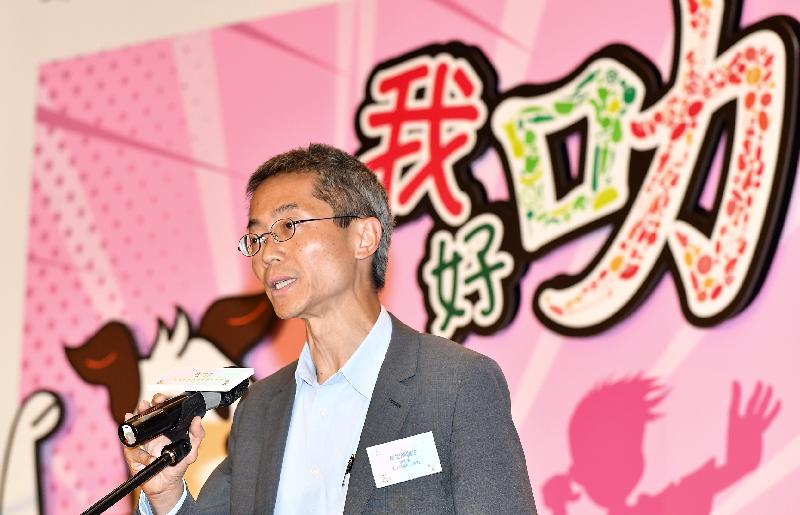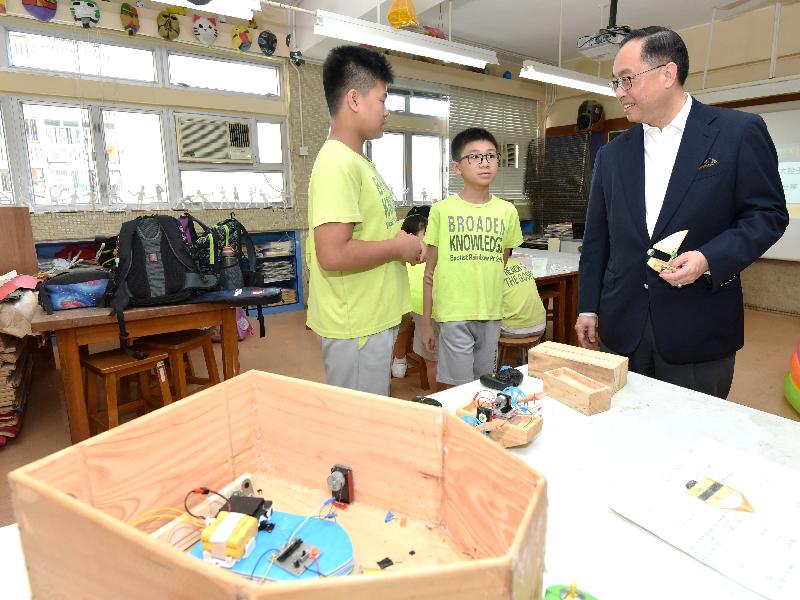Following is the speech by the Secretary for Financial Services and the Treasury, Mr James Lau, at the Speaker Luncheon of the Hong Kong Institute of Directors (HKIoD) today (May 17):
Henry (Chairman of the HKIoD, Mr Henry Lai), distinguished guests, ladies and gentlemen,
Good afternoon. I am delighted to join you all at today’s luncheon hosted by the Hong Kong Institute of Directors. Corporate governance is a priority subject for the HKIoD. It is a very timely topic today in light of the new listing regime that came into effect on April 30, allowing high growth and innovative companies to list with a weighted voting rights (WVR) structure on the main board of the Stock Exchange of Hong Kong.
The unstoppable wave of innovation and technology, so-called Industrial Revolution 4.0, is a global phenomenon that has fundamentally changed the world’s economic structure and way of living. Many sizable new economy companies have emerged around the world, and also many unicorns with a valuation over US$1 billion. An estimate suggests that at end-March 2018, China alone had more than 150 unicorns, and over 30 of them appeared in the first quarter of this year. So you can see the pace of development. In Hong Kong, we are conscious that our capital markets and economy need to evolve to keep pace with such a sea change.
The new listing regime was adopted following two rounds of consultation conducted by the Stock Exchange. In the first round, the Exchange put forward a concept paper on a “New Board.” A total of 360 valid responses were received, and an overwhelming majority was supportive of the need to widen the listing criteria on the current board to attract a more diverse range of issuers.
In the second round, the Exchange put forward specific proposals to amend its listing rules to facilitate the listing of companies from emerging and innovative sectors. Again, most of the 283 responses received supported the Exchange’s proposals in general. In the end, the Exchange also made some modifications to address concerns from the industry.
Let me now do a brief recap on the WVR regime, and then I’d like to address in particular the safeguards in place and also a certain critique on the adequacy of the safeguards provisions. Under the amended listing rules, companies with a WVR structure would be required to have a minimum expected market capitalisation of HK$10 billion at listing and, if below HK$40 billion of market capitalisation, would need to have at least HK$1 billion of revenue in their most recent audited financial year. This market cap requirement is higher than conventional listing entities.
Also, the company must be an innovative company, and the applicant must demonstrate a track record of high business growth. The applicant must also have previously received meaningful third party investment from at least one sophisticated investor, which must remain at IPO.
While the listing door is opened to companies with a WVR structure, what is equally important are the appropriate safeguards we have put in place to protect the investing public.
The first safeguard is ringfencing. Only new applicants will be able to list with a WVR structure, and the Exchange will seek to ensure that companies do not use artificial means to circumvent this. After listing, issuers with WVR structures will be prohibited from increasing the proportion of WVRs in issue.
Secondly, restrictions for WVR beneficiaries. At present, WVR beneficiaries must be an individual who has an active executive role within the business, and is contributing to a material extent to the growth of the business. WVR beneficiaries must be directors of the issuer at listing and remain as directors afterwards.
Thirdly, limits on the power of WVR beneficiaries. A class of shares conferring WVRs in a listed issuer must not entitle the beneficiary to more than 10 times the voting power of ordinary shares. In relation to the question of a possible privatisation, I should add that WVR shareholders, as controlling shareholders, will not be able to vote, and a privatisation proposal can be blocked by one tenth of the independent shareholders.
Fourthly, protection of non-WVR shareholders’ right to vote. Non-WVR shareholders must be able to convene an extraordinary general meeting and add resolutions to the meeting agenda. The minimum stake required to do so must be no higher than 10 per cent of the voting rights on a one-share one-vote basis.
Fifthly, a number of key matters must be decided on a one-share one-vote basis. These include changes to the listed issuer’s constitutional documents, whichever forms they are; variation of rights attached to any class of shares; the appointment or removal of independent non-executive directors; the appointment or removal of auditors; and the voluntary winding-up of the issuer.
Sixthly, an issuer with a WVR structure must establish a corporate governance committee that comprises only independent non-executive directors. This committee will review and monitor potential conflict of interest between the issuer, a subsidiary of the issuer or shareholders of the issuer on the one hand and any beneficiary of weighted voting rights on the other. The board of directors needs to consider the recommendations of the corporate governance committee fully, and it needs to comply or explain. This is a requirement that we have strengthened after the consultation exercise in light of concerns expressed.
Seventhly, enhanced disclosure. The listed equity securities of an issuer with a WVR structure must have a stock name that ends with the stock marker “W”. An issuer with a WVR structure must also include the warning “A company controlled through weighted voting rights” on the front page of all listing documents, periodic financial reports, circulars, notifications and announcements.
The issuer should describe the WVR structure, the issuer’s rationale for having it and the associated risks for shareholders prominently in its listing documents and periodic financial reports. And an issuer with a WVR structure must also identify the beneficiaries of WVRs, disclose the impact of a potential conversion of WVR shares into ordinary shares on its share capital, and disclose all circumstances in which the WVRs attached to its shares will cease in its listing documents and in its interim and annual reports.
Last but not least, we have built in event-based sunset clauses. The WVRs attached to a beneficiary’s shares will cease upon transfer of the beneficial ownership of those shares or the control over the voting rights attached to them.
The WVRs attached to beneficiaries’ shares will also lapse permanently if a WVR beneficiary dies, ceases to be a director, or is deemed by the Stock Exchange to be incapacitated for the purpose of performing his or her duties as a director, or is deemed to no longer meet the requirements of a director set out in the listing rules.
Now let me turn to the question of adequacy of these safeguards. Some in the investor community are concerned that there is still not enough protection for investors. This is particularly true in light of the increasing popularity of passive funds that invest in indices by default without consideration of share class structures. In fact, the IPO of a technology company in the US last year which offered shares with no voting rights at all triggered various index companies to launch consultations on the inclusion of WVR shares in their indices. By the way, such zero voting right WVR structure is not permitted in Hong Kong.
Now, market index companies have taken different approaches on this subject. FTSE Russell concluded that new constituents in their indices would be required to have no less than 5 per cent of the company’s aggregate voting rights owned by unrestricted shareholders. S&P Dow Jones announced that it would not allow companies with dual-class structures to be part of some of its high-profile indices, such as the S&P 500 Index. And the MSCI suggested that it would adjust the weights of stocks with WVR structures in their indices so as to reflect the unequal voting rights. These measures would to a certain extent mitigate the issue for passive index funds.
Another issue often raised by investors is the absence of a class action regime in Hong Kong, which some believe will provide the answer to what it means for investor protection. Having said that, only a small number of respondents to the Exchange’s consultation considered the introduction of a class action regime to be a pre-requisite for permitting the listing of WVR companies in our market.
On the contrary, some market participants are concerned that there is a higher risk of frivolous cases being brought forward if a class action regime was introduced in Hong Kong. I would also note that class action cases in the US were most often brought in relation to the disclosure of information, and not for the abuse of control that possibly arose under a WVR structure. In the UK, class action is limited to cases in the Competition Appeal Tribunal, a specialist judicial body whose function is to hear and decide cases involving competition or economic regulatory issues.
When it comes to the practice in Hong Kong, the courts in Hong Kong have unfettered discretion under the existing rules to issue appropriate orders to try actions involving decisions made by the management of the WVR companies. The court may, by order, consolidate or try two or more claims on the same occasion. Relevant court cases indicate that the court has discretion in deciding whether or not to consolidate the actions.
In addition, the court can handle proceedings involving the same interest of numerous persons through “representative proceedings” when a plaintiff proposed to represent in the proceeding meets the threefold test of establishing “a common interest, a common grievance and a remedy which is beneficial to all the plaintiffs”.
The court is also empowered, on the application of the plaintiffs, to appoint a defendant to act as representative of the other defendants being sued. A judgment or order given in representative proceedings will be binding on all persons so represented. So this is quite close in a way to the effect of a class action.
A third issue sometimes raised by investors is the absence of a time-defined sunset clause for WVR beneficiaries in our listing regime. I would like to point out that the US and the UK do not have a requirement of compulsory sunset clauses. And there are also views in Hong Kong that a time-defined sunset clause may not be in the best interest of the company or its shareholders because it may trigger a change in control at a listed issuer at an arbitrary date in future. This could potentially create excessive uncertainty for shareholders and prospective investors as that date approaches. The Exchange had taken these various views into account and come up with a set of event-based sunset provisions in order to provide a right balance in protecting investors and the WVR beneficiaries.
There are others who think that the current safeguards we have in place are too tight. Some suggest corporate beneficiaries of WVRs should be allowed. This is a very complex subject. And questions arise on whether there is appropriate ringfencing for corporate WVR holders, better protection for investors against such “perpetual” rights, the availability of a suitable sunset requirement, and other restrictions on the exercise of corporate WVR rights. The Stock Exchange of Hong Kong plans to launch a consultation later this year to further explore this option, and we would welcome your comments and contributions.
Ladies and gentlemen, in conclusion, we will continue to keep in view the global economic environment and conduct timely reviews of our listing regime, so as to maintain the competitiveness and quality of our market. Enhanced corporate governance is an integral part of the safeguards in our expanded listing regime, and I look forward to the HKIoD’s continued participation in such conversation on how we can achieve a proper balance between encouraging market evolution to meet development needs and maintaining market quality and investor protection. Thank you. read more










